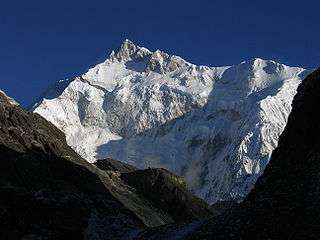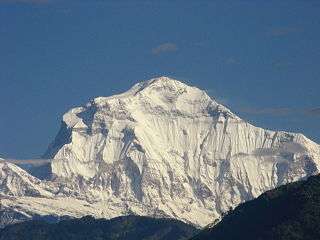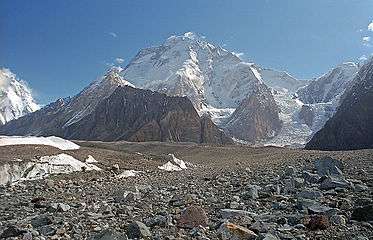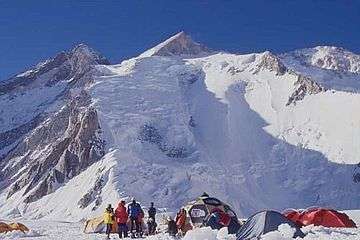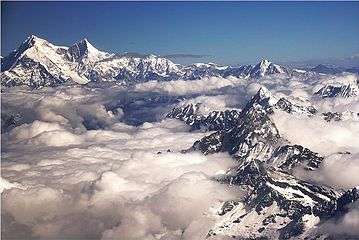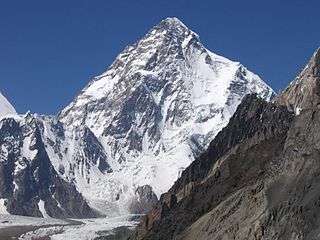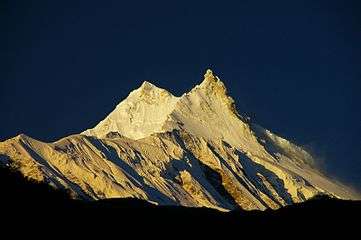There are at least 109 mountains with elevations greater than 7,200 metres (23,622 ft) above sea level. All of these mountains are located in southern and central Asia. Only those summits are included that, by an objective measure, may be considered individual mountains as opposed to subsidiary peaks.
Considerations

Figure demonstrating the concept of
topographic prominence: The prominence of a peak is the height of the peak’s summit above the lowest contour line encircling it and no higher summit. For example, vertical arrows show the topographic prominence of three peaks on an island. A dotted horizontal line links each peak (except the highest) to its key
col.
The dividing line between a mountain with multiple peaks and separate mountains is not always clear (see also Highest unclimbed mountain). A popular and intuitive way to distinguish mountains from subsidiary peaks is by their height above the highest saddle connecting it to a higher summit, a measure called topographic prominence or re-ascent (the higher summit is called the "parent peak"). A common definition of a mountain is a summit with 300 m (980 ft) prominence. Alternatively, a relative prominence (prominence/height) is used (usually 7–8%) to reflect that in higher mountain ranges everything is on a larger scale. The table below lists the highest 100 summits with at least 500 m (1,640 ft) prominence, approximating a 7% relative prominence. A drawback of a prominence-based list is that it may exclude well-known or spectacular mountains that are connected via a high ridge to a taller summit, such as Eiger or Nuptse. A few such peaks and mountains with nearly sufficient prominence are included but not numbered in this list.
It is very unlikely that all given heights are correct to the nearest metre; indeed, the sea level is often problematic to define when a mountain is remote from the sea. Different sources often differ by many metres, and the heights given below may well differ from those elsewhere in this encyclopedia. As an extreme example, Ulugh Muztagh on the north Tibetan Plateau is often listed as 7,723 m (25,338 ft) to 7,754 m (25,440 ft), but appears to be only 6,973 m (22,877 ft) to 6,987 m (22,923 ft). Some mountains differ by > 100 m (330 ft) on different maps, while even very thorough current measurements of Mount Everest range from 8,840 m (29,003 ft) to 8,850 m (29,035 ft). These discrepancies serve to emphasize the uncertainties in the listed heights.
Though some parts of the world, especially the most mountainous parts, have never been thoroughly mapped, it is unlikely that any mountains this high have been overlooked, because synthetic aperture radar can and has been used to measure elevations of most otherwise inaccessible places. Still, heights and/or prominences may be revised, so that the order of the list may change and even "new" mountains could enter the list over time. To be safe, the list has been extended to include all 7,200 m (23,622 ft) peaks.
The highest mountains above sea level are generally not the highest above the surrounding terrain. There is no precise definition of surrounding base, but Denali, Mount Kilimanjaro and Nanga Parbat are possible candidates for the tallest mountain on land by this measure. The bases of mountain islands are below sea level, and given this consideration Mauna Kea (4,207 m (13,802 ft) above sea level) is the world's tallest mountain and volcano, rising about 10,203 m (33,474 ft) from the Pacific Ocean floor. Ojos del Salado has the greatest rise on Earth—13,420 m (44,029 ft) from the summit to the bottom of the Atacama Trench about 560 km (350 mi) away, though most of this rise is not part of the mountain.
The highest mountains are also not generally the most voluminous. Mauna Loa (4,169 m or 13,678 ft) is the largest mountain on Earth in terms of base area (about 2,000 sq mi or 5,200 km2) and volume (about 10,000 cu mi or 42,000 km3), although, due to the intergrade of lava from Kilauea, Hualalai and Mauna Kea, the volume can only be estimated based on surface area and height of the edifice. Mt. Kilimanjaro is the largest non-shield volcano in terms of both base area (245 sq mi or 635 km2) and volume (1,150 cu mi or 4,793 km3). Mount Logan is the largest non-volcanic mountain in base area (120 sq mi or 311 km2).
The highest mountains above sea level are also not those with peaks farthest from the centre of the Earth, because the figure of the Earth is not spherical. Sea level closer to the equator is several kilometres farther from the centre of the Earth. The summit of Chimborazo, Ecuador's tallest mountain, is usually considered to be the farthest point from the Earth's centre, although the southern summit of Peru's tallest mountain, Huascarán, is another contender.[1] Both have elevations above sea level more than 2 km less than that of Everest.
Geographical distribution
Most mountains in the list are located in the Himalaya and Karakoram ranges to the south and west of the Tibetan plateau. In fact, all 7,000 m (23,000 ft) peaks in the world are located in the centre of Asia (East Asia, Central Asia and South Asia) in a rectangle edged by Noshaq (7,492 m or 24,580 ft) on the Afghanistan-Pakistan border in the West, Jengish Chokusu, (Tuōmù'ěr Fēng) (7,439 m or 24,406 ft) on the Kyrgyzstan – Xinjiang border to the North, Gongga Shan (Minya Konka) (7,556 m or 24,790 ft) in Sichuan to the East, and Kabru (7,412 m or 24,318 ft) on the Sikkim (India) – Nepal border to the South.
The highest mountain outside of Asia is Aconcagua (6,962 m or 22,841 ft), which one list has ranking 189th in the world amongst mountains with a 500 m or 1,640 ft prominence cutoff.[2]
The locations of the highest mountains are shown on the composite satellite image of High Asia below. The numbers refer to the ranking in the list. For clarity, lower peaks with labels overlapping higher peaks are left out of the main image. The boxed regions are those with the highest density of summits and are enlarged in two separate images to show all peaks.
Composite NASA map of highest peaks
Location of peaks in the Hindu Kush and Karakoram
Location of peaks in the Nepal Himalaya
List
| Rank |
Mountain |
Height[3] |
Prominence
(m)[4] |
Range |
Coordinates[5] |
Parent mountain
[6] |
First
ascent |
Ascents
(failed attempts)
bef. 2004[7] |
|---|
| m |
ft |
| 1 |
Mount Everest /
Sagarmatha /
Chomolungma |
8,848[8] |
29,029 |
8,848 |
Mahalangur Himalaya |
27°59′17″N 86°55′31″E / 27.98806°N 86.92528°E / 27.98806; 86.92528 (1. Mount Everest / Sagarmatha / Chomolungma (8848 m)) |
none |
1953 |
>>145 (121) |
| 2 |
K2 / Qogir /
Godwin Austen |
8,611 |
28,251 |
4,017 |
Baltoro Karakoram |
35°52′53″N 76°30′48″E / 35.88139°N 76.51333°E / 35.88139; 76.51333 (2. K2 / Qogir / Godwin Austen (8611 m)) |
Mount Everest[9] |
1954 |
45 (44) |
| 3 |
Kangchenjunga |
8,586 |
28,169 |
3,922 |
Kangchenjunga Himalaya |
27°42′12″N 88°08′51″E / 27.70333°N 88.14750°E / 27.70333; 88.14750 (3. Kangchenjunga (8586 m)) * |
Mount Everest |
1955 |
38 (24) |
| 4 |
Lhotse |
8,516 |
27,940 |
610 |
Mahalangur Himalaya |
27°57′42″N 86°55′59″E / 27.96167°N 86.93306°E / 27.96167; 86.93306 (4. Lhotse (8516 m)) |
Mount Everest |
1956 |
26 (26) |
| 5 |
Makalu |
8,485 |
27,838 |
2,386 |
Mahalangur Himalaya |
27°53′23″N 87°05′20″E / 27.88972°N 87.08889°E / 27.88972; 87.08889 (5. Makalu (8485 m)) |
Mount Everest |
1955 |
45 (52) |
| 6 |
Cho Oyu [10] |
8,188 |
26,864 |
2,340 |
Mahalangur Himalaya |
28°05′39″N 86°39′39″E / 28.09417°N 86.66083°E / 28.09417; 86.66083 (6. Cho Oyu (8188 m)) |
Mount Everest |
1954 |
79 (28) |
| 7 |
Dhaulagiri I |
8,167 |
26,795 |
3,357 |
Dhaulagiri Himalaya |
28°41′48″N 83°29′35″E / 28.69667°N 83.49306°E / 28.69667; 83.49306 (7. Dhaulagiri I (8167 m)) |
K2 |
1960 |
51 (39) |
| 8 |
Manaslu |
8,163 |
26,781 |
3,092 |
Manaslu Himalaya |
28°33′00″N 84°33′35″E / 28.55000°N 84.55972°E / 28.55000; 84.55972 (8. Manaslu (8163 m)) |
Cho Oyu |
1956 |
49 (45) |
| 9 |
Nanga Parbat |
8,126 |
26,660 |
4,608 |
Nanga Parbat Himalaya |
35°14′14″N 74°35′21″E / 35.23722°N 74.58917°E / 35.23722; 74.58917 (9. Nanga Parbat (8126 m)) |
Dhaulagiri |
1953 |
52 (67) |
| 10 |
Annapurna I |
8,091 |
26,545 |
2,984 |
Annapurna Himalaya |
28°35′44″N 83°49′13″E / 28.59556°N 83.82028°E / 28.59556; 83.82028 (10. Annapurna I (8091 m)) |
Cho Oyu |
1950 |
36 (47) |
| 11 |
Gasherbrum I /
Hidden Peak / K5 |
8,080 |
26,509 |
2,155 |
Baltoro Karakoram |
35°43′28″N 76°41′47″E / 35.72444°N 76.69639°E / 35.72444; 76.69639 (11. Gasherbrum I / Hidden Peak / K5 (8080 m)) |
K2 |
1958 |
31 (16) |
| 12 |
Broad Peak / K3 |
8,051 |
26,414 |
1,701 |
Baltoro Karakoram |
35°48′38″N 76°34′06″E / 35.81056°N 76.56833°E / 35.81056; 76.56833 (12. Broad Peak / K3 (8051 m)) |
Gasherbrum I |
1957 |
39 (19) |
| 13 |
Gasherbrum II / K4 |
8,035 |
26,362 |
1,524 |
Baltoro Karakoram |
35°45′28″N 76°39′12″E / 35.75778°N 76.65333°E / 35.75778; 76.65333 (13. Gasherbrum II / K4 (8035 m)) |
Gasherbrum I |
1956 |
54 (12) |
| 14 |
Shishapangma |
8,027 |
26,335 |
2,897 |
Jugal Himalaya |
28°21′12″N 85°46′43″E / 28.35333°N 85.77861°E / 28.35333; 85.77861 (14. Shishapangma (8027 m)) |
Cho Oyu |
1964 |
43 (19) |
| 15 |
Gyachung Kang |
7,952 |
26,089 |
700 |
Mahalangur Himalaya |
28°05′53″N 86°44′42″E / 28.09806°N 86.74500°E / 28.09806; 86.74500 (15. Gyachung Kang (7952 m)) |
Cho Oyu |
1964 |
5 (3) |
| 110 |
Gasherbrum III |
7,946 |
26,070 |
355 |
Baltoro Karakoram |
35°45′33″N 76°38′30″E / 35.75917°N 76.64167°E / 35.75917; 76.64167 (Gasherbrum III (7946 m)) |
Gasherbrum II |
1975 |
2 (2) |
| 16 |
Annapurna II |
7,937 |
26,040 |
2,437 |
Annapurna Himalaya |
28°32′05″N 84°07′19″E / 28.53472°N 84.12194°E / 28.53472; 84.12194 (16. Annapurna II (7937 m)) |
Annapurna I |
1960 |
6 (19) |
| 17 |
Gasherbrum IV |
7,932 |
26,024 |
715 |
Baltoro Karakoram |
35°45′38″N 76°36′58″E / 35.76056°N 76.61611°E / 35.76056; 76.61611 (17. Gasherbrum IV (7932 m)) |
Gasherbrum III |
1958 |
4 (11) |
| 18 |
Himalchuli |
7,893 |
25,896 |
1,633 |
Manaslu Himalaya |
28°26′12″N 84°38′23″E / 28.43667°N 84.63972°E / 28.43667; 84.63972 (18. Himalchuli (7893 m)) * |
Manaslu |
1960 |
6 (12) |
| 19 |
Distaghil Sar |
7,884 |
25,866 |
2,525 |
Hispar Karakoram |
36°19′33″N 75°11′16″E / 36.32583°N 75.18778°E / 36.32583; 75.18778 (19. Distaghil Sar (7884 m)) |
K2 |
1960 |
3 (5) |
| 20 |
Ngadi Chuli |
7,871 |
25,823 |
1,020 |
Manaslu Himalaya |
28°30′12″N 84°34′00″E / 28.50333°N 84.56667°E / 28.50333; 84.56667 (20. Ngadi Chuli (7871 m)) |
Manaslu |
1970 |
2 (6) |
| 111 |
Nuptse |
7,864 |
25,801 |
319 |
Mahalangur Himalaya |
27°58′03″N 86°53′13″E / 27.96750°N 86.88694°E / 27.96750; 86.88694 (Nuptse (7864 m)) |
Lhotse |
1961 |
5 (12) |
| 21 |
Khunyang Chhish |
7,823 |
25,666 |
1,765 |
Hispar Karakoram |
36°12′19″N 75°12′28″E / 36.20528°N 75.20778°E / 36.20528; 75.20778 (21. Khunyang Chhish (7823 m)) * |
Distaghil Sar |
1971 |
2 (6) |
| 22 |
Masherbrum / K1 |
7,821 |
25,659 |
2,457 |
Masherbrum Karakoram |
35°38′28″N 76°18′21″E / 35.64111°N 76.30583°E / 35.64111; 76.30583 (22. Masherbrum / K1 (7821 m)) |
Gasherbrum I |
1960 |
4 (9) |
| 23 |
Nanda Devi |
7,816 |
25,643 |
3,139 |
Garhwal Himalaya |
30°22′33″N 79°58′15″E / 30.37583°N 79.97083°E / 30.37583; 79.97083 (23. Nanda Devi (7816 m)) |
Dhaulagiri |
1936 |
14 (12) |
| 24 |
Chomo Lonzo |
7,804 |
25,604 |
590 |
Mahalangur Himalaya |
27°55′50″N 87°06′28″E / 27.93056°N 87.10778°E / 27.93056; 87.10778 (24. Chomo Lonzo (7804 m)) |
Makalu |
1954 |
3 (1) |
| 25 |
Batura Sar |
7,795 |
25,574 |
3,118 |
Batura Karakoram |
36°30′37″N 74°31′21″E / 36.51028°N 74.52250°E / 36.51028; 74.52250 (25. Batura Sar (7795 m)) |
Distaghil Sar |
1976 |
4 (6) |
| 26 |
Kanjut Sar |
7,790 |
25,558 |
1,690 |
Hispar Karakoram |
36°12′20″N 75°25′01″E / 36.20556°N 75.41694°E / 36.20556; 75.41694 (26. Kanjut Sar (7790 m)) |
Khunyang Chhish |
1959 |
2 (1) |
| 27 |
Rakaposhi |
7,788 |
25,551 |
2,818 |
Rakaposhi-Haramosh Karakoram |
36°08′33″N 74°29′22″E / 36.14250°N 74.48944°E / 36.14250; 74.48944 (27. Rakaposhi (7788 m)) |
Khunyang Chhish |
1958 |
8 (13) |
| 28 |
Namcha Barwa |
7,782 |
25,531 |
4,106 |
Assam Himalaya |
29°37′52″N 95°03′19″E / 29.63111°N 95.05528°E / 29.63111; 95.05528 (28. Namcha Barwa (7782 m)) |
Kangchenjunga |
1992 |
1 (2) |
| 29 |
Kamet |
7,756 |
25,446 |
2,825 |
Garhwal Himalaya |
30°55′12″N 79°35′30″E / 30.92000°N 79.59167°E / 30.92000; 79.59167 (29. Kamet (7756 m)) * |
Nanda Devi |
1931 |
23 (14) |
| 30 |
Dhaulagiri II |
7,751 |
25,430 |
2,396 |
Dhaulagiri Himalaya |
28°45′46″N 83°23′18″E / 28.76278°N 83.38833°E / 28.76278; 83.38833 (30. Dhaulagiri II (7751 m)) |
Dhaulagiri |
1971 |
4 (11) |
| 31 |
Saltoro Kangri / K10 |
7,742 |
25,400 |
2,160 |
Saltoro Karakoram |
35°23′57″N 76°50′53″E / 35.39917°N 76.84806°E / 35.39917; 76.84806 (31. Saltoro Kangri / K10 (7742 m)) * |
Gasherbrum I |
1962 |
2 (1) |
| 32 |
Jannu |
7,711 |
25,299 |
1,036 |
Kangchenjunga Himalaya |
27°40′56″N 88°02′40″E / 27.68222°N 88.04444°E / 27.68222; 88.04444 (32. Jannu (7711 m)) * |
Kangchenjunga |
1962 |
17 (12) |
| 33 |
Tirich Mir |
7,708 |
25,289 |
3,910 |
Hindu Kush |
36°15′19″N 71°50′30″E / 36.25528°N 71.84167°E / 36.25528; 71.84167 (33. Tirich Mir (7708 m)) * |
Batura Sar |
1950 |
20 (11) |
| 112 |
Molamenqing |
7,703 |
25,272 |
430 |
Langtang Himalaya |
28°21′18″N 85°48′35″E / 28.35500°N 85.80972°E / 28.35500; 85.80972 (Molamenqing (7703 m)) |
Shishapangma |
1981 |
1 (0) |
| 34 |
Gurla Mandhata |
7,694 |
25,243 |
2,788 |
Nalakankar Himalaya |
30°26′19″N 81°17′48″E / 30.43861°N 81.29667°E / 30.43861; 81.29667 (34. Gurla Mandhata (7694 m)) |
Dhaulagiri |
1985 |
6 (4) |
| 35 |
Saser Kangri I / K22 |
7,672 |
25,171 |
2,304 |
Saser Karakoram |
34°52′00″N 77°45′09″E / 34.86667°N 77.75250°E / 34.86667; 77.75250 (35. Saser Kangri I / K22 (7672 m)) |
Gasherbrum I |
1973 |
6 (4) |
| 36 |
Chogolisa |
7,665 |
25,148 |
1,624 |
Masherbrum Karakoram |
35°36′47″N 76°34′29″E / 35.61306°N 76.57472°E / 35.61306; 76.57472 (36. Chogolisa (7665 m)) |
Masherbrum |
1975 |
4 (2) |
| 113 |
Dhaulagiri IV |
7,661 |
25,135 |
469 |
Dhaulagiri Himalaya |
28°44′09″N 83°18′55″E / 28.73583°N 83.31528°E / 28.73583; 83.31528 (Dhaulagiri IV (7661 m)) |
Dhaulagiri II |
1975 |
2 (10) |
| 37 |
Kongur Tagh |
7,649 |
25,095 |
3,585 |
Kongur Shan (Eastern Pamirs) |
38°35′36″N 75°18′48″E / 38.59333°N 75.31333°E / 38.59333; 75.31333 (37. Kongur Tagh (7649 m)) |
Distaghil Sar |
1981 |
2 (4) |
| 114 |
Dhaulagiri V |
7,618 |
24,993 |
340 |
Dhaulagiri Himalaya |
28°44′02″N 83°21′41″E / 28.73389°N 83.36139°E / 28.73389; 83.36139 (Dhaulagiri V (7618 m)) * |
Dhaulagiri IV |
1975 |
2 (3) |
| 38 |
Shispare |
7,611 |
24,970 |
1,240 |
Batura Karakoram |
36°26′26″N 74°40′51″E / 36.44056°N 74.68083°E / 36.44056; 74.68083 (38. Shispare (7611 m)) |
Batura Sar |
1974 |
3 (1) |
| 39 |
Trivor |
7,577 |
24,859 |
980 |
Hispar Karakoram |
36°17′15″N 75°05′06″E / 36.28750°N 75.08500°E / 36.28750; 75.08500 (39. Trivor (7577 m)) * |
Distaghil Sar |
1960 |
2 (5) |
| 40 |
Gangkhar Puensum |
7,570 |
24,836 |
2,995 |
Kula Kangri Himalaya |
28°02′50″N 90°27′19″E / 28.04722°N 90.45528°E / 28.04722; 90.45528 (40. Gangkhar Puensum (7570 m)) * |
Kangchenjunga |
unclimbed |
0 (3) |
| 41 |
Gongga Shan /
Minya Konka |
7,556 |
24,790 |
3,642 |
Daxue Shan (Hengduan Shan) |
29°35′43″N 101°52′47″E / 29.59528°N 101.87972°E / 29.59528; 101.87972 (41. Gongga Shan / Minya Konka (7556 m)) |
Mount Everest |
1932 |
6 (7) |
| 42 |
Annapurna III |
7,555 |
24,787 |
703 |
Annapurna Himalaya |
28°35′06″N 83°59′24″E / 28.58500°N 83.99000°E / 28.58500; 83.99000 (42. Annapurna III (7555 m)) |
Annapurna I |
1961 |
10 (17) |
| 43 |
Muztagh Ata |
7,546 |
24,757 |
2,735 |
Muztagata (Eastern Pamirs) |
38°16′33″N 75°06′58″E / 38.27583°N 75.11611°E / 38.27583; 75.11611 (43. Muztagh Ata (7546 m)) |
Kongur Tagh |
1956 |
Many |
| 44 |
Skyang Kangri |
7,545 |
24,754 |
1,085 |
Baltoro Karakoram |
35°55′35″N 76°34′03″E / 35.92639°N 76.56750°E / 35.92639; 76.56750 (44. Skyang Kangri (7545 m)) |
K2 |
1976 |
1 (2) |
| 45 |
Changtse |
7,543 |
24,747 |
520 |
Mahalangur Himalaya |
28°01′29″N 86°54′51″E / 28.02472°N 86.91417°E / 28.02472; 86.91417 (45. Changtse (7543 m)) |
Mount Everest |
1982 |
9 (9) |
| 46 |
Kula Kangri |
7,538 |
24,731 |
1,650 |
Kula Kangri Himalaya |
28°13′37″N 90°36′59″E / 28.22694°N 90.61639°E / 28.22694; 90.61639 (46. Kula Kangri (7538 m)) |
Gangkhar Puensum |
1986 |
3 (2) |
| 47 |
Kongur Tiube |
7,530 |
24,705 |
840 |
Kongur Shan (Eastern Pamirs) |
38°36′57″N 75°11′45″E / 38.61583°N 75.19583°E / 38.61583; 75.19583 (47. Kongur Tiube (7530 m)) |
Kongur Tagh |
1956 |
2 (3) |
| 48 |
Mamostong Kangri |
7,516 |
24,659 |
1,803 |
Rimo Karakoram |
35°08′31″N 77°34′39″E / 35.14194°N 77.57750°E / 35.14194; 77.57750 (48. Mamostong Kangri (7516 m)) |
Gasherbrum I |
1984 |
5 (0) |
| 49 |
Saser Kangri II E |
7,513 |
24,649 |
1,450 |
Saser Karakoram |
34°48′17″N 77°48′24″E / 34.80472°N 77.80667°E / 34.80472; 77.80667 (49. Saser Kangri II E (7513 m)) |
Saser Kangri I |
2011 |
0 (0)[11] |
| 50 |
Ismoil Somoni Peak |
7,495 |
24,590 |
3,402 |
Pamir (Academy of Sciences Range) |
38°56′35″N 72°00′57″E / 38.94306°N 72.01583°E / 38.94306; 72.01583 (50. Ismoil Somoni Peak (7495 m)) |
Muztagh Ata |
1933 |
|
| 51 |
Saser Kangri III |
7,495 |
24,590 |
850 |
Saser Karakoram |
34°50′44″N 77°47′06″E / 34.84556°N 77.78500°E / 34.84556; 77.78500 (51. Saser Kangri III (7495 m)) |
Saser Kangri I |
1986 |
1 (0) |
| 52 |
Noshaq |
7,492 |
24,580 |
2,024 |
Hindu Kush |
36°25′56″N 71°49′43″E / 36.43222°N 71.82861°E / 36.43222; 71.82861 (52. Noshaq (7492 m)) |
Tirich Mir |
1960 |
33 (3) |
| 53 |
Pumari Chhish |
7,492 |
24,580 |
890 |
Hispar Karakoram |
36°12′41″N 75°15′01″E / 36.21139°N 75.25028°E / 36.21139; 75.25028 (53. Pumari Chhish (7492 m)) |
Khunyang Chhish |
1979 |
1 (2) |
| 54 |
Passu Sar |
7,476 |
24,528 |
645 |
Batura Karakoram |
36°29′16″N 74°35′16″E / 36.48778°N 74.58778°E / 36.48778; 74.58778 (54. Passu Sar (7476 m)) |
Batura Sar |
1994 |
1 (0) |
| 55 |
Yukshin Gardan Sar |
7,469 |
24,505 |
1,313 |
Hispar Karakoram |
36°15′04″N 75°22′29″E / 36.25111°N 75.37472°E / 36.25111; 75.37472 (55. Yukshin Gardan Sar (7469 m)) |
Pumari Chhish |
1984 |
4 (1) |
| 56 |
Teram Kangri I |
7,462 |
24,482 |
1,702 |
Siachen Karakoram |
35°34′48″N 77°04′42″E / 35.58000°N 77.07833°E / 35.58000; 77.07833 (56. Teram Kangri I (7462 m)) |
Gasherbrum I |
1975 |
2 (0) |
| 57 |
Jongsong Peak |
7,462 |
24,482 |
1,298 |
Kangchenjunga Himalaya |
27°52′54″N 88°08′09″E / 27.88167°N 88.13583°E / 27.88167; 88.13583 (57. Jongsong Peak (7462 m)) |
Kangchenjunga |
1930 |
2 (3) |
| 58 |
Malubiting |
7,458 |
24,469 |
2,193 |
Rakaposhi-Haramosh Karakoram |
36°00′12″N 74°52′31″E / 36.00333°N 74.87528°E / 36.00333; 74.87528 (58. Malubiting (7458 m)) |
Rakaposhi |
1971 |
2 (6) |
| 59 |
Gangapurna |
7,455 |
24,459 |
563 |
Annapurna Himalaya |
28°36′18″N 83°57′49″E / 28.60500°N 83.96361°E / 28.60500; 83.96361 (59. Gangapurna (7455 m)) |
Annapurna III |
1965 |
8 (13) |
| 60 |
Jengish Chokusu /
Tömür / Pk Pobeda |
7,439 |
24,406 |
4,148 |
Tian Shan |
42°02′05″N 80°07′47″E / 42.03472°N 80.12972°E / 42.03472; 80.12972 (60. Jengish Chokusu / Tömür / Pk Pobeda (7439 m)) |
Ismail Samani Peak |
1956 |
|
| 115 |
Sunanda Devi |
7,434 |
24,390 |
260 |
Garhwal Himalaya |
30°22′00″N 79°59′40″E / 30.36667°N 79.99444°E / 30.36667; 79.99444 (Sunanda Devi (7434 m)) |
Nanda Devi |
1939 |
14 (12) |
| 61 |
K12 |
7,428 |
24,370 |
1,978 |
Saltoro Karakoram |
35°17′45″N 77°01′20″E / 35.29583°N 77.02222°E / 35.29583; 77.02222 (61. K12 (7428 m)) |
Saltoro Kangri |
1974 |
4 (2) |
| 62 |
Yangra /
Ganesh I |
7,422 |
24,350 |
2,352 |
Ganesh Himalaya |
28°23′29″N 85°07′38″E / 28.39139°N 85.12722°E / 28.39139; 85.12722 (62. Yangra / Ganesh I (7422 m)) |
Manaslu |
1955 |
1 (6) |
| 63 |
Sia Kangri |
7,422 |
24,350 |
640 |
Siachen Karakoram |
35°39′48″N 76°45′42″E / 35.66333°N 76.76167°E / 35.66333; 76.76167 (63. Sia Kangri (7422 m)) |
Gasherbrum I |
1934 |
6 (0) |
| 64 |
Momhil Sar |
7,414 |
24,324 |
980 |
Hispar Karakoram |
36°19′04″N 75°02′11″E / 36.31778°N 75.03639°E / 36.31778; 75.03639 (64. Momhil Sar (7414 m)) * |
Trivor |
1964 |
2 (6) |
| 65 |
Kabru N |
7,412 |
24,318 |
780 |
Kangchenjunga Himalaya |
27°38′02″N 88°07′00″E / 27.63389°N 88.11667°E / 27.63389; 88.11667 (65. Kabru N (7412 m)) |
Kangchenjunga |
1994 |
1 (2)[12] |
| 66 |
Skil Brum |
7,410 |
24,311 |
1,152 |
Baltoro Karakoram |
35°51′03″N 76°25′43″E / 35.85083°N 76.42861°E / 35.85083; 76.42861 (66. Skil Brum (7410 m)) |
K2 |
1957 |
2 (1) |
| 67 |
Haramosh Peak |
7,409 |
24,308 |
2,277 |
Rakaposhi-Haramosh Karakoram |
35°50′24″N 74°53′51″E / 35.84000°N 74.89750°E / 35.84000; 74.89750 (67. Haramosh Peak (7409 m)) |
Malubiting |
1958 |
4 (3) |
| 68 |
Istor-o-Nal |
7,403 |
24,288 |
1,040 |
Hindu Kush |
36°22′32″N 71°53′54″E / 36.37556°N 71.89833°E / 36.37556; 71.89833 (68. Istor-o-Nal (7403 m)) |
Noshaq |
1969 |
4 (5) |
| 69 |
Ghent Kangri |
7,401 |
24,281 |
1,493 |
Saltoro Karakoram |
35°31′04″N 76°48′02″E / 35.51778°N 76.80056°E / 35.51778; 76.80056 (69. Ghent Kangri (7401 m)) |
Saltoro Kangri |
1961 |
4 (0) |
| 70 |
Ultar |
7,388 |
24,239 |
700 |
Batura Karakoram |
36°23′27″N 74°43′00″E / 36.39083°N 74.71667°E / 36.39083; 74.71667 (70. Ultar (7388 m)) |
Shispare |
1996 |
2 (5) |
| 71 |
Rimo I |
7,385 |
24,229 |
1,438 |
Rimo Karakoram |
35°21′18″N 77°22′08″E / 35.35500°N 77.36889°E / 35.35500; 77.36889 (71. Rimo I (7385 m)) |
Teram Kangri I |
1988 |
1 (3) |
| 72 |
Churen Himal |
7,385 |
24,229 |
600 |
Dhaulagiri Himalaya |
28°44′05″N 83°13′03″E / 28.73472°N 83.21750°E / 28.73472; 83.21750 (72. Churen Himal (7385 m)) |
Dhaulagiri IV |
1970 |
3 (0) |
| 73 |
Teram Kangri III |
7,382 |
24,219 |
520 |
Siachen Karakoram |
35°35′59″N 77°02′53″E / 35.59972°N 77.04806°E / 35.59972; 77.04806 (73. Teram Kangri III (7382 m)) |
Teram Kangri I |
1979 |
1 (0) |
| 74 |
Sherpi Kangri |
7,380 |
24,213 |
1,000 |
Saltoro Karakoram |
35°27′58″N 76°46′53″E / 35.46611°N 76.78139°E / 35.46611; 76.78139 (74. Sherpi Kangri (7380 m)) * |
Ghent Kangri |
1976 |
1 (1) |
| 75 |
Labuche Kang |
7,367 |
24,170 |
1,957 |
Labuche Himalaya |
28°18′15″N 86°21′03″E / 28.30417°N 86.35083°E / 28.30417; 86.35083 (75. Labuche Kang (7367 m)) |
Cho Oyu |
1987 |
1 (0) |
| 76 |
Kirat Chuli |
7,362 |
24,153 |
1,168 |
Kangchenjunga Himalaya |
27°47′16″N 88°11′43″E / 27.78778°N 88.19528°E / 27.78778; 88.19528 (76. Kirat Chuli (7362 m)) |
Kangchenjunga |
1939 |
1 (6) |
| 116 |
Abi Gamin |
7,355 |
24,131 |
217 |
Garhwal Himalaya |
30°55′57″N 79°36′09″E / 30.93250°N 79.60250°E / 30.93250; 79.60250 (Abi Gamin (7355 m)) |
Kamet |
1950 |
17 (2) |
| 77 |
Nangpai Gosum |
7,350 |
24,114 |
500 |
Mahalangur Himalaya |
28°04′24″N 86°36′51″E / 28.07333°N 86.61417°E / 28.07333; 86.61417 (77. Nangpai Gosum (7350 m)) |
Cho Oyu |
1996 |
3 (1) |
| 117 |
Gimmigela / The Twins |
7,350 |
24,114 |
432 |
Kangchenjunga Himalaya |
27°44′27″N 88°09′31″E / 27.74083°N 88.15861°E / 27.74083; 88.15861 (Gimmigela / The Twins (7350 m)) |
Kangchenjunga |
1994 |
3 (1) |
| 78 |
Saraghrar |
7,349 |
24,111 |
1,979 |
Hindu Kush |
36°32′51″N 72°06′54″E / 36.54750°N 72.11500°E / 36.54750; 72.11500 (78. Saraghrar (7349 m)) |
Noshaq |
1959 |
2 (3) |
| 79 |
Jomolhari |
7,326 |
24,035 |
2,077 |
Jomolhari Himalaya |
27°49′36″N 89°16′04″E / 27.82667°N 89.26778°E / 27.82667; 89.26778 (79. Jomolhari (7326 m)) * |
Gangkhar Puensum |
1937 |
4 (0) |
| 80 |
Chamlang |
7,321 |
24,019 |
1,240 |
Mahalangur Himalaya |
27°46′30″N 86°58′47″E / 27.77500°N 86.97972°E / 27.77500; 86.97972 (80. Chamlang (7321 m)) |
Lhotse |
1961 |
7 (1) |
| 81 |
Chongtar |
7,315 |
23,999 |
1,300 |
Baltoro Karakoram |
35°54′55″N 76°25′45″E / 35.91528°N 76.42917°E / 35.91528; 76.42917 (81. Chongtar (7315 m)) |
Skil Brum |
1994 |
1 (1) |
| 82 |
Baltoro Kangri |
7,312 |
23,990 |
1,200 |
Masherbrum Karakoram |
35°38′21″N 76°40′24″E / 35.63917°N 76.67333°E / 35.63917; 76.67333 (82. Baltoro Kangri (7312 m)) |
Chogolisa |
1976 |
1 (0) |
| 83 |
Siguang Ri |
7,309 |
23,980 |
650 |
Mahalangur Himalaya |
28°08′50″N 86°41′06″E / 28.14722°N 86.68500°E / 28.14722; 86.68500 (83. Siguang Ri (7309 m)) |
Cho Oyu |
1989 |
2 (1) |
| 84 |
The Crown / Huang Guan |
7,295 |
23,934 |
1,919 |
Yengisogat Karakoram |
36°06′24″N 76°12′21″E / 36.10667°N 76.20583°E / 36.10667; 76.20583 (84. The Crown / Huang Guan (7295 m)) |
Skil Brum (K2) |
1993 |
1 (3) |
| 85 |
Gyala Peri |
7,294 |
23,930 |
2,942 |
Assam Himalaya |
29°48′52″N 94°58′07″E / 29.81444°N 94.96861°E / 29.81444; 94.96861 (85. Gyala Peri (7294 m)) |
Mount Everest |
1986 |
1 (0) |
| 86 |
Porong Ri |
7,292 |
23,924 |
520 |
Langtang Himalaya |
28°23′22″N 85°43′12″E / 28.38944°N 85.72000°E / 28.38944; 85.72000 (86. Porong Ri (7292 m)) |
Shisha Pangma |
1982 |
5 (0) |
| 87 |
Baintha Brakk / The Ogre |
7,285 |
23,901 |
1,891 |
Panmah Karakoram |
35°56′51″N 75°45′12″E / 35.94750°N 75.75333°E / 35.94750; 75.75333 (87. Baintha Brakk / The Ogre (7285 m)) * |
Kanjut Sar |
1977 |
3 (13) |
| 88 |
Yutmaru Sar |
7,283 |
23,894 |
620 |
Hispar Karakoram |
36°13′35″N 75°22′02″E / 36.22639°N 75.36722°E / 36.22639; 75.36722 (88. Yutmaru Sar (7283 m)) |
Yukshin Gardan Sar |
1980 |
1 (1) |
| 89 |
Baltistan Peak / K6 |
7,282 |
23,891 |
1,962 |
Masherbrum Karakoram |
35°25′06″N 76°33′06″E / 35.41833°N 76.55167°E / 35.41833; 76.55167 (89. Baltistan Peak / K6 (7282 m)) |
Chogolisa |
1970 |
1 (3) |
| 90 |
Kangpenqing /
Gang Benchhen |
7,281 |
23,888 |
1,340 |
Baiku Himalaya |
28°33′03″N 85°32′44″E / 28.55083°N 85.54556°E / 28.55083; 85.54556 (90. Kangpenqing / Gang Benchhen (7281 m)) |
Shisha Pangma |
1982 |
1 (1) |
| 91 |
Muztagh Tower |
7,276 |
23,871 |
1,710 |
Baltoro Karakoram |
35°49′40″N 76°21′40″E / 35.82778°N 76.36111°E / 35.82778; 76.36111 (91. Muztagh Tower (7276 m)) |
Skil Brum |
1956 |
4 (2) |
| 92 |
Mana Peak |
7,272 |
23,858 |
730 |
Garhwal Himalaya |
30°52′50″N 79°36′55″E / 30.88056°N 79.61528°E / 30.88056; 79.61528 (92. Mana Peak (7272 m)) |
Kamet |
1937 |
7 (3) |
| 118 |
Dhaulagiri VI |
7,268 |
23,845 |
485 |
Dhaulagiri Himalaya |
28°42′31″N 83°16′27″E / 28.70861°N 83.27417°E / 28.70861; 83.27417 (Dhaulagiri VI (7268 m)) |
Dhaulagiri IV |
1970 |
5 (0) |
| 93 |
Diran |
7,266 |
23,839 |
1,325 |
Rakaposhi-Haramosh Karakoram |
36°07′13″N 74°39′42″E / 36.12028°N 74.66167°E / 36.12028; 74.66167 (93. Diran (7266 m)) |
Malubiting |
1968 |
12 (8) |
| 94 |
Labuche Kang III / East[13] |
7,250 |
23,786 |
570 |
Labuche Himalaya |
28°18′05″N 86°23′02″E / 28.30139°N 86.38389°E / 28.30139; 86.38389 (94. Labuche Kang III / East (7250 m)) |
Labuche Kang |
unclimbed |
0 (0) |
| 95 |
Putha Hiunchuli |
7,246 |
23,773 |
1,151 |
Dhaulagiri Himalaya |
28°44′52″N 83°08′46″E / 28.74778°N 83.14611°E / 28.74778; 83.14611 (95. Putha Hiunchuli (7246 m)) |
Churen Himal |
1954 |
11 (5) |
| 96 |
Apsarasas Kangri |
7,245 |
23,770 |
635 |
Siachen Karakoram |
35°32′19″N 77°08′55″E / 35.53861°N 77.14861°E / 35.53861; 77.14861 (96. Apsarasas Kangri (7245 m)) |
Teram Kangri I |
1976 |
2 (0) |
| 97 |
Mukut Parbat |
7,242 |
23,760 |
840 |
Garhwal Himalaya |
30°56′57″N 79°34′12″E / 30.94917°N 79.57000°E / 30.94917; 79.57000 (97. Mukut Parbat (7242 m)) |
Kamet |
1951 |
2 (1) |
| 98 |
Rimo III |
7,233 |
23,730 |
615 |
Rimo Karakoram |
35°22′31″N 77°21′42″E / 35.37528°N 77.36167°E / 35.37528; 77.36167 (98. Rimo III (7233 m)) |
Rimo I |
1985 |
1 (0) |
| 99 |
Langtang Lirung |
7,227 |
23,711 |
1,525 |
Langtang Himalaya |
28°15′22″N 85°31′01″E / 28.25611°N 85.51694°E / 28.25611; 85.51694 (99. Langtang Lirung (7227 m)) |
Shisha Pangma |
1978 |
14 (13) |
| 100 |
Karjiang |
7,221 |
23,691 |
880 |
Kula Kangri Himalaya |
28°15′27″N 90°38′49″E / 28.25750°N 90.64694°E / 28.25750; 90.64694 (100. Karjiang (7221 m)) |
Kula Kangri |
unclimbed |
0 (2) |
| 101 |
Annapurna Dakshin |
7,219 |
23,684 |
775 |
Annapurna Himalaya |
28°31′06″N 83°48′22″E / 28.51833°N 83.80611°E / 28.51833; 83.80611 (101. Annapurna Dakshin (7219 m)) |
Annapurna |
1964 |
10 (16) |
| 102 |
Khartaphu |
7,213 |
23,665 |
712 |
Mahalangur Himalaya |
28°03′49″N 86°58′39″E / 28.06361°N 86.97750°E / 28.06361; 86.97750 (102. Khartaphu (7213 m)) |
Mount Everest |
1935 |
1 (0) |
| 103 |
Tongshanjiabu[14] |
7,207 |
23,645 |
1,757 |
Lunana Himalaya |
28°11′12″N 89°57′27″E / 28.18667°N 89.95750°E / 28.18667; 89.95750 (103. Tongshanjiabu (7207 m)) |
Gangkar Puensum |
unclimbed |
0 (0) |
| 104 |
Malangutti Sar |
7,207 |
23,645 |
515 |
Hispar Karakoram |
36°21′47″N 75°08′57″E / 36.36306°N 75.14917°E / 36.36306; 75.14917 (104. Malangutti Sar (7207 m)) |
Distaghil Sar |
1985 |
1 (0) |
| 105 |
Noijin Kangsang /
Norin Kang |
7,206 |
23,642 |
2,160 |
Nagarze Himalaya |
28°56′48″N 90°10′42″E / 28.94667°N 90.17833°E / 28.94667; 90.17833 (105. Noijin Kangsang / Norin Kang (7206 m)) |
Gangkar Puensum |
1986 |
4 (1) |
| 106 |
Langtang Ri |
7,205 |
23,638 |
650 |
Langtang Himalaya |
28°22′53″N 85°41′01″E / 28.38139°N 85.68361°E / 28.38139; 85.68361 (106. Langtang Ri (7205 m)) |
Shisha Pangma |
1981 |
4 (0) |
| 107 |
Kangphu Kang |
7,204 |
23,635 |
1,200 |
Lunana Himalaya |
28°09′20″N 90°03′48″E / 28.15556°N 90.06333°E / 28.15556; 90.06333 (107. Kangphu Kang (7204 m)) |
Tongshanjiabu |
2002 |
1 (0) |
| 108 |
Singhi Kangri |
7,202 |
23,629 |
790 |
Siachen Karakoram |
35°35′59″N 76°59′01″E / 35.59972°N 76.98361°E / 35.59972; 76.98361 (108. Singhi Kangri (7202 m)) |
Teram Kangri III |
1976 |
2 (0) |
| 109 |
Lupghar Sar |
7,200 |
23,622 |
730 |
Hispar Karakoram |
36°21′01″N 75°02′13″E / 36.35028°N 75.03694°E / 36.35028; 75.03694 (109. Lupghar Sar (7200 m)) * |
Momhil Sar |
1979 |
1 (0) |
Stem and leaf plot
The following is a stem and leaf plot of the above data. The two digits to the left of the line are the first two digits of the mountain's height (metres), and each digit to the right of the line represents the third digit of the mountain's height. Each number on the right is linked to the corresponding mountain's article. For example, the height of one of the mountains (namely Mount Everest) is 8848 meters. Also, it is apparent that there are five mountains above 8,200 metres.
88 | 4
87 |
86 | 1
85 | 8 1
84 | 8
83 |
82 |
81 | 8 6 6 2
80 | 9 8 5 3 2
79 | 5 4 3 3
78 | 9 8 7 6 2 2 1 0
77 | 9 9 8 8 5 5 4 1 0 0
76 |
9 7 6 6 4 1 1
75 | 7 7 5 5 4 4 4 3 3 1 1
74 | 9 9 9 9 7 6 6 6 5 5 3 3 2 2 2 1 1 1 0 0 0
73 | 8 8 8 8 8 6 6 5 5 5 4 2 1 1 1 0
72 | 9 9 9 8 8 8 8 7 7 6 6 5 4 4 4 3 2 2 1 1 0 0 0 0 0 0 0
Gallery
See also
References
- ↑ Krulwich, Robert (April 7, 2007). "The 'Highest' Spot on Earth?". Retrieved 21 March 2009.
- ↑ "High Asia summits over 6,750 metres high with 500 metres of re-ascent". viewfinderpanoramas.org. Retrieved January 10, 2014.
- ↑ For Nepal, the heights indicated on the Nepal Topographic Maps are followed. For China and the Baltoro Karakoram, the heights are those of "The Maps of Snow Mountains in China". For the Hispar Karakoram the heights on a Russian 1:100,000 topo map seem to be more accurate than the customarily quoted heights probably based on US army maps from the 50s . Elsewhere, unless otherwise indicated, heights are those in Jill Neate's "High Asia".
- ↑ The prominence data were extracted from a combination of maps and computer aided analysis of NASA's 3" SRTM data. Prominences over 1,450 m were copied from this website.
- ↑ Coordinates were established by comparing topographical maps with satellite images and SRTM-derived terrain maps. The terrain maps and satellite images often don't match exactly. An asterisk (*) indicates that the map and image are shifted by more than 100 m (4") and/or that the landscapes around the summit don't match.
- ↑ Here defined as the first higher mountain beyond the key saddle with at least 500 m prominence itself.
- ↑ The number of ascents and failed attempts up to 2004 is extracted from the Club Himalayan index. These are the number of expeditions (not individuals) that announced their ascent or attempt in a journal. They are probably quite accurate for the rarely climbed peaks (though omissions were noted), but greatly underestimate the number of ascending parties on the easier and/or more popular mountains, like most eight-thousanders. For instance, Mt Everest has been scaled 2,251 times by individuals up to 2004 .
- ↑ Given the large differences between multiple "final" measurements of Mt Everest, the traditional 8,848 m is listed. For more information, see Mount Everest#Measurement.
- ↑ Everest IS parent to K2 by the definition of topographic prominence. See also, the discussion page.
- ↑ Cho Oyu's height is 8,188 m according to the Nepal Survey's 1996 topographical map H8615, which represents the best known measurement to date. Previous estimates have been 8,153 m and 8,201 m
- ↑ The highest (Eastern) summit of Saser Kangri II was climbed on August 24th, 2011 / p / steve-swenson-status. The lower West peak, 2.5 km away, has been climbed in 1984 and twice since.
- ↑ According to the 1996 Himalayan Journal (pp.29–36), the highest point of the Kabru massif (the North summit) was climbed by an Indian Army team in May 1994
- ↑ The height is unknown, but over 7,200 meters on both Chinese and Russian maps of the area.
- ↑ The name and information about this summit was extracted from the May 2003 edition of Japanese Alpine News.
Sources
- "High Asia: An Illustrated History of the 7,000 Metre Peaks" by Jill Neate (Mountaineers Books 1990)
- "The Maps of Snow Mountains in China" by Mi Desheng (Chinese Academy of Science, 1990s)
- "Nepal Topographic Maps" by the Finnish Meteorological Inst. (Nepalese Survey Dept., 1990s)
- Soviet military 1:100,000 topographic maps (most from 1980–1981)
- The "High Mountain Info" section of the "High Mountain Sports Magazine" (1990–2005) (now Climb Magazine)
- Some other topographic maps and much from the external links listed above.
External links



.png)
.png)

